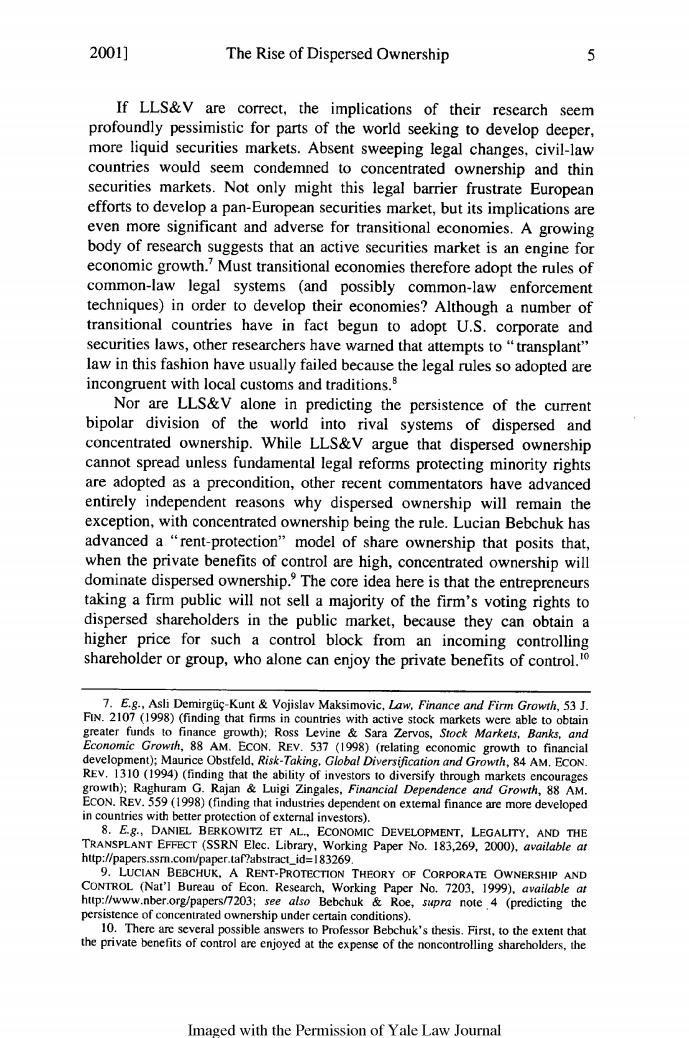正在加载图片...

2001) The Rise of Dispersed Ownership 5 If LLS&v are correct,the implications of their research seem profoundly pessimistic for parts of the world seeking to develop deeper. more liquid securities markets.Absent sweeping legal changes.civil-law countries would seem condemned to concentrated ownership and thin securities markets.Not ony might this legal barrier frustrate European efforts to develop a pan-European securities market,but its implications are even more significant and dverse for transitional economies.A growing body of research suggests that an active securities market is an engine for economic growth.'Must transitional economies therefore adopt the rules of common-law legal systems (and possibly common-law enforcement techniques)in order to de ugh a number of countries have in fact begun to adopt U.S.corporate and securities laws,other researchers have warned that attempts to"transplant" law in this fashion have usually failed because the legal rules so adopted are incongruent with local customs and traditions. Nor are LLS&V alone in predicting the persistence of the current bipolar division of the world into rival systems of dispersed and concentrated ownership.While LLS&V argue that dispersed ownership cannot spread unless fundamental legal reforms protecting minority right are adopted as a ndition othe recent tors ave advanced entirely independent reasons why dispersed ownership will remain the exception,with concentrated ownership being the rule.Lucian Bebchuk has advanced a "rent-protection"model of share ownership that posits that. when the private benefits of control are high,conc ed ownership wil ninate dispersed ownership.The core idea here is that the entrepreneurs taking a firm public will not sell a majority of the firm's voting rights to dispersed shareholders in the public market,because they can obtain a higher price for such a control block from an incoming controll shareholder or group,who alone can enjoy the priv ate enefit of cont o Asli Dem 53 ms in co tai EGmnCon arke Dive 84 AM.ECO an&Luigi Zingales.Financ nd Growth,88 AM finance are more developed in countries with better aper-ta CONTROL (Nat']Bureau of con.Resea chuk Roe,supra note 4 (predicting the rs to Professor Beb uk's thesis.First.to the extent that he are enjoyed at the of the sha holders.the Imaged with the permission of Yale law lournal The Rise of Dispersed Ownership If LLS&V are correct, the implications of their research seem profoundly pessimistic for parts of the world seeking to develop deeper, more liquid securities markets. Absent sweeping legal changes, civil-law countries would seem condemned to concentrated ownership and thin securities markets. Not only might this legal barrier frustrate European efforts to develop a pan-European securities market, but its implications are even more significant and adverse for transitional economies. A growing body of research suggests that an active securities market is an engine for economic growth.7 Must transitional economies therefore adopt the rules of common-law legal systems (and possibly common-law enforcement techniques) in order to develop their economies? Although a number of transitional countries have in fact begun to adopt U.S. corporate and securities laws, other researchers have warned that attempts to "transplant" law in this fashion have usually failed because the legal rules so adopted are incongruent with local customs and traditions.8 Nor are LLS&V alone in predicting the persistence of the current bipolar division of the world into rival systems of dispersed and concentrated ownership. While LLS&V argue that dispersed ownership cannot spread unless fundamental legal reforms protecting minority rights are adopted as a precondition, other recent commentators have advanced entirely independent reasons why dispersed ownership will remain the exception, with concentrated ownership being the rule. Lucian Bebchuk has advanced a "rent-protection" model of share ownership that posits that, when the private benefits of control are high, concentrated ownership will dominate dispersed ownership.' The core idea here is that the entrepreneurs taking a firm public will not sell a majority of the firm's voting rights to dispersed shareholders in the public market, because they can obtain a higher price for such a control block from an incoming controlling shareholder or group, who alone can enjoy the private benefits of control." 7. E.g., Ash Demirgtii-Kunt & Vojislav Maksimovic, Law, Finance and Finn Growth, 53 J. FIN. 2107 (1998) (finding that firms in countries with active stock markets were able to obtain greater funds to finance growth); Ross Levine & Sara Zervos, Stock Markets, Banks, and Economic Growth, 88 AM. ECON. REV. 537 (1998) (relating economic growth to financial development); Maurice Obstfeld, Risk-Taking, Global Diversification and Growth, 84 AM. ECON. REv. 1310 (1994) (finding that the ability of investors to diversify through markets encourages growth); Raghuram G. Rajan & Luigi Zingales, Financial Dependence and Growth, 88 AM. ECON. REV. 559 (1998) (finding that industries dependent on external finance are more developed in countries with better protection of external investors). 8. E.g., DANIEL BERKOWITZ ET AL., ECONOMIC DEVELOPMENT, LEGALITY, AND THE TRANSPLANT EFFECT (SSRN Elec. Library, Working Paper No. 183,269, 2000), available at http://papers.ssm.com/paper.tafabstractid= 183269. 9. LUCIAN BEBCHUK, A RENT-PROTECTION THEORY OF CORPORATE OWNERSHIP AND CONTROL (Nat'l Bureau of Econ. Research, Working Paper No. 7203, 1999), available at http:l/www.nber.org/papers7203; see also Bebchuk & Roe, supra note 4 (predicting the persistence of concentrated ownership under certain conditions). 10. There are several possible answers to Professor Bebchuk's thesis. First, to the extent that the private benefits of control are enjoyed at the expense of the noncontrolling shareholders, the Imaged with the Permission of Yale Law Journal 2001]